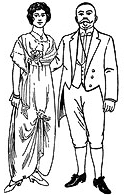Dance, But Not That Way . . .
Dance and etiquette manuals in the 19th and early 20th centuries offered instruction on dance steps as well as advice on everything from grooming habits to acceptable dialogue during a dance. How would you have fared?
1. According to an 1850 dance and etiquette manual, it was acceptable for a woman to raise her dress to the ankle:
when crossing over a mud puddle. According to The lady's guide to perfect gentility: Raising the dress.— When tripping over the pavement, a lady should gracefully raise her dress a little above her ancle. With the right hand, she should hold together the folds of her gown, and draw them towards the right side. To raise the dress on both sides, and with both hands, is vulgar. This ungraceful practice can only be tolerated for a moment, when the mud is very deep.
2. Leads balance 2 bars to the right and 2 bars to the left, heel and toe, and chasse; leads half right and left, while the side couples balance, 4 bars; sides right and left while leads waltz on station, 4 bars; leads repeat the same to places, sides repeat to places.
Follow these instructions from the 1866 manual The ball-room monitor to find yourself dancing the:
Serious Family Polka
3. The manual American dancing master, and ball-room prompter (1862), authored by Elias Howe and "several eminent professors of dancing," described which of the following as the proper way for a gentleman to bow in the ballroom?
Stand in the third position, right foot in front; slide the right foot a little to the side. Draw the left foot in front of the third position. Incline the head and the body a little; let your arms fall easily and naturally. Rise in the third position, left foot in front.
4. According to Clog-Dancing Made Easy (1874), how long should one practice each day in order to master this skill?
 2 hours. The manual advises, "After having mastered the form of the step, practise it at any convenient opportunity, though it is much better to have a specified hour each day. Two hours per day is little enough if the student is ambitious of excellence."
2 hours. The manual advises, "After having mastered the form of the step, practise it at any convenient opportunity, though it is much better to have a specified hour each day. Two hours per day is little enough if the student is ambitious of excellence."
5. In Albert W. Newman's Dances of to-day (1914), these dance positions, respectively, are called:
 Open Position; Yale Position
Open Position; Yale Position
6. Which of the following, according to The Public Dance Halls of Chicago, was not a critique by the Juvenile Protection Association of the Chicago public dance halls in 1917:
". . . policewomen detailed to public dance halls have been seen dancing and therefore not affording protection to young girls and serving somewhat in the capacity of municipal chaperones." The Juvenile Protective Association held out hope that "when women were put upon the police force of Chicago, they would be detailed to public dance halls" to protect young girls but despite their many requests, policewomen did not regularly appear at dance halls. Policemen were criticized for "confin[ing] their attention to interfering when fights are in progress."
In the 19th century, the number of advice manuals grew exponentially, including those designed to teach the complicated rules and regulations associated with ballroom dancing. Manuals also offered etiquette and fashion advice. By the end of the 19th century, simpler dance steps grew in popularity. In the next few decades, new technologies brought further change as dancers listened to music on records and watched new dance steps on the silver screen. For more background, see "Western Social Dance: An Overview of the Collection" and "How to Read a Dance Manual."
- All materials are from the Library of Congress, American Memory, An American Ballroom Companion: Dance Instruction Manuals, ca. 1490-1920




